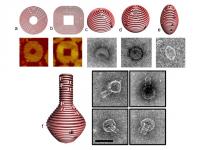A research team led by HaoYan and Yan Liu at the Arizona State University's Biodesign Institute has enhanced the ability of DNA origami to create irregular, two and three-dimensional shapes simulating natural ones.
These nanostructures could be used in multiple products such as nano computing parts, nanomedicines to identify and eliminate atypical cells or offer remedies at the cellular or molecular level. A recent issue of Science has published the Yan team method to use and expand the design capability of DNA. The new method could help develop nanostructures featuring complicated curves.
 AUS's Schematics for 2D nanoforms
AUS's Schematics for 2D nanoforms
The team used the DNA molecule like a flexible building material. DNA origami generally helps create a two-dimensional shape, after which this polygonal outline is filled with short pieces of dual-stranded DNA, aligned in parallel arrays. The segments resemble pixels on a computer screen.
Short DNA staple strands bind the structured shapes together. The nucleotide sequence of the scaffold strand runs through each helix in the design. This is strengthened by the staple strands via base pairing.
The team wanted to develop a technique that would allow researchers to develop irregular three-dimensional shapes monitoring the surface curvature. They outlined the target surface features with the scaffold and then controlled the DNA shaping of crossover networks to arrive at the required design. The team fabricated concentric ring structures from a DNA double helix that are bound together with crossover points. One strand in a double helix shifts to an adjacent ring, connecting two concentric helices to prevent the DNA from stretching. The network can also produce in-plane and out-of-plane curvature, to enable curved three-dimensional nanostructures. This procedure helped produce spheres, hemispheres, ellipsoid shells and a round-bottomed nanoflask, which appears in transmission electron microscopy images. The closed, three-dimensional nanoforms like the sphere could help its application in biomedicine.